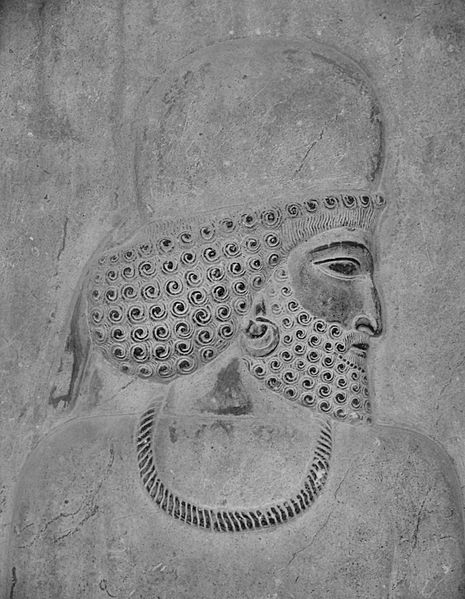Image: Mad-5223

Description: "Māda" (Median) herald leading a delegation on the famous tribute bearers bas-relief decorating the southern panel of the eastern stairway of the Apadana, Darius the Great’s audience hall at Persepolis, one of the capital of the Achaemenian Persian Empire (515 BCE). The southern panel hosts a set of 23 bas-reliefs describing the procession of tribute bearers of 23 nations subjected to the king of the kings. Each delegation is leaded by alternating Persian and Median heralds, and brings the king various gifts from everywhere in the empire. As many inscriptions let us know, by such pictorial representation, the king of kings claims his authority on all these provinces, the supremacy of the Persian and Median nations on the others, and acknowledge the great diversity of his giant empire. Although still being a topic of controversy, most of the delegations are identified with the help of the analysis of the dressings, hairdressing, ethnophysical specificities seen on the various characters, or also using some comparison with lists of the subjected nations left on the Achaemenian royal inscriptions. In this case, there is no possible mistake as this character is a herald and not a tribute bearer, and as he wears a typical median felt hat with a tail on the back. If the persian were ruling the empire with their former median rulers, some parts of the median tribes were considered as subjected, probably for having made the wrong choice, opposing Cyrus the Great when the founder of the Achaemenian dynasty struggled against median king Astyages. The execution of those reliefs obeys to strict rules set by the king himself, letting no artistic freedom to the carver. Although many of the artists working on Persepolis were not Persian themselves but coming from all across the empire (Egyptians, Greeks of minor Asia etc…), the style of the sculpture is typically Persian and undoubtly oriental, as testify the profile face & frontal chest posture. The marble sculptures were polished until obtaining a nearly completely erased grain, giving the Achaemenian Ronde-Bosse its particular quality. The use of polychromic pigments to colorize the reliefs in the fashion of those friezes seen in Suza, another Achaemenian capital remain yet an unanswered question. If Suza’s Apadana wall decoration was polychromic, if stigmatas of pigments were attested
Title: Mad-5223
Credit: Own work
Author: Alborzagros
Usage Terms: Creative Commons Attribution-Share Alike 3.0
License: CC BY-SA 3.0
License Link: http://creativecommons.org/licenses/by-sa/3.0
Attribution Required?: Yes
Image usage
The following page links to this image:

